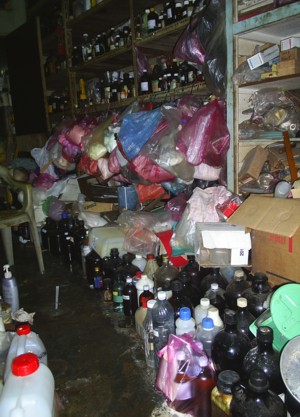.JPG)
Living on a Boat in Thailand
2006
7 December 2006
We’ve just got back to Phuket after a little 6 week holiday down south in Malaysia – Langkawi and Penang. While we were there we organised our new Thai visas, bought a couple of thousand litres of diesel (our first purchase since Kumai in October last year) and took the opportunity to stock up on duty free goodies for Christmas.
Since March we had been moored pretty much permanently at Ao Chalong, the big shallow bay that is the main yacht anchorage for Phuket island, where the Immigration, Customs and the harbourmaster “one stop shop” is stationed.
We’ve arrived back to find that a large chunk of the 2006 rally fleet (from Australia) has arrived and is around on the west side of Phuket Island participating in the King’s Cup or anchored here. So we are on the outer fringe of the anchorage area, well over a kilometre offshore. The sunken wreck that sticks up at low tide is still here. Despite using all his charm on the various authorities, numerous letters and photos, Philip’s mission to get rid of it seems to have failed.
And there’s now also a sunken 60’ dive boat – only its flybridge visible at high tide. The remarkable thing about this one, though, is that it still swings on its mooring – but under water. Apart from the wrecks, and the many boats, anchoring here is made interesting by the “public” moorings scattered throughout. Unlike most moorings in Australia, they have hugely long ropes and so swing in large circles as the wind veers around.
Most of what follows was written as we travelled north……
2 December 2006
I’m sitting at the dinette, typing and Philip is perched in the helm seat, keeping watch, as we bounce into a current-affected, half metre swelly/wavy thing a little off our nose. We are having a typical NE monsoon morning of about 15 knots from the northeast as we head north from Butang Island towards Koh Rok Nok (40 nautical miles, about a 6 hour trip). Koh Butang is the closest Thai island to Malaysian Langkawi, unoccupied and part of a marine national park.
The autopilot is doing the steering – as usual when we’re not conning in close quarters – so when we’re travelling we sit around doing whatever we like to fill in time. We always have one of us in the helm seat on watch (no reading or any other activity except maybe going to the toilet or making a cup of tea).
Sometimes the warmth and hum of the engine make falling asleep a real possibility so the helmsman gets to have a nap whenever he wants, while I take over. (When we do long passages involving overnighting we do formal watches of 2 hours on and 2 hours off but we have done only 2 or 3 of those since leaving Australia. We like to travel in daylight.)
Langkawi is a funny place. A beautiful island with high mountains in the middle, white beaches, several resorts, an international airport and duty free to boot. You’d think it would be a cert. for successful tourism, but it’s not.
They have quite a few hifalutin’ multistorey hotels located plum in the middle of a country town with open drains. Nothing seems to relate to anything else in style or transportation. There are a few obvious tourism opportunities that, in Thailand, someone would be on to like a shot. But in Langkawi, no-one cares. It’s like tourism designed by a committee and run by not very creative bureaucrats.
Which is not to say we don’t like Langkawi. If you’ve read any of our previous scratchings, you’ll already know we prefer dagginess to style everywhere we go. And a lot of the establishments here are decidedly daggy, even though the evident policy remnants of Dr Mahathir’s reign, are decidedly pretentious.
(Eg we love the Roti shop in Kuah with the blue plastic tablecloths. This place doesn’t even rate plastic chairs – you sit on stools and like it. Sure they have a bit of crud on the tablecloths attended by a few flies but they make a mean murtabak.)
Definitely not daggy are the elegant Malaysian women in their long colourful satin tunics over long skirts and artfully draped hijabs.

Spotted at the ferry terminal at Kuah – definitely not daggy!
It’s great to be in cruising mode again. This trip has shaken off the inertia we get when we’re holed up in one place for very long.
Yesterday at Koh Butang we snorkelled in the best environment with the clearest water we have seen since Indonesia. One site was like a landscape of giant fairy toadstools with other smaller corals and clams populating the spaces. (Not many large fish and, having seen a longtail working with three divers and hookah gear, we know why.)
Our anchorage was the sort of Cid harbour (this is an anchorage in the Whitsunday islands) of the Butangs. Formed by 4 big islands and several small ones, this bay is protected from just about every direction except east. The islands are tall and densely forested, the trees shading silica white beaches. The water is clear and dark green. Quiet and delightful.
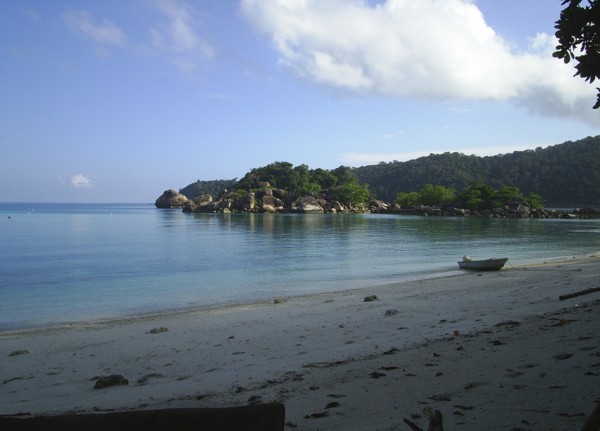
Butang Island
Sometimes we say to ourselves: it doesn’t feel like we’ve been living overseas for more than a year. But other times we become acutely aware of our surroundings. Right now I really feel like I’m in South East Asia. Earlier today we were sitting in the cockpit watching a family of monkeys on the beach. Big Dad leading the way, a few Mums doing the shopping amongst the trees and a couple of kids racing and tumbling behind.
The fishing boats came in last night amidst a dense white rain storm complete with lightning and thunder. Now they’re formed into a few rafts in the middle of the bay. Could be a party? There are usually about 20 crew on every boat, so for every 6 boats – 120 people - someone would be having a birthday nearly every day.
Boating is different here in Thailand. We were anchored overnight at Koh Rok Nok a while back, a pretty coral island 50nm south of Phuket. Looking out I could see a western boat. I knew it was a western boat by his lights - red and green and on the right sides! The fishing boats sometimes have red, green and white lights– it’s just that they put them wherever they like. At anchor he showed a white anchor light - not red, white, green or blue and it didn’t flash.
We’ve “gone native” and now sport a red flashing anchor light as well as our proper white one. These wonderful inventions are LED missile shaped “torches”. You tie them in the rigging and they turn themselves on at sunset and off at dawn. They take 2 D size batteries that last one month. And they cost about $7. Better than a garden light like most of the yachts have in Australia. We’ve been using one since we first bought it in Langkawi 9 months ago.
We are also flying a “King” flag alongside our Thai courtesy flag. These are bright yellow with the Royal crest printed on them. They are everywhere in Thailand, flown alongside the national flag on every office building, shop, most homes and some cars and motorbikes. More than half the Thais are also decked out in bright yellow polo shirts with the crest (and Philip has bought one of those too).
This year is the sixtieth anniversary of the King’s ascension to the throne. He’s been ruling for the same length of time as Her Maj. QE. But what a difference. He’s absolutely adored by the population. And for good reason; He’s thoroughly admirable. Not only very accomplished but also helps the poor in practical and creative ways – like starting a water buffalo bank to lend to farmers who can’t afford to buy them or cloud seeding for rain in drought affected areas or creating an experimental farm in the palace grounds. Lots of stuff.
We were lucky enough to get a glimpse of a dress rehearsal for the Royal Barge Procession down the Chao Praya River in Bangkok when we were there in May. Over fifty gold barges with 2,000 oarsmen dressed in ancient style Siamese fashion chanting as they paddled. The Thais really know how to do “royal”. Lots of gold, jewel-encrusted buildings, regalia and clothing, royal palanqins and hundreds of bearers.
Interestingly, the Thai royal family was in exile before King Mahidol ascended the throne and not particularly revered. He was educated at a Catholic school in America.
Huge photos of the royal family, like this are all over Thailand, alongside the roads, adorning buildings etc and individuals have photos on the wall at home and inside their business premises.
On 27 September 2006 we experienced our first coup d’etat. I was in Laos with my sister. We wondered if we would be able to get flights back to Bangkok, but, no worries, all was back to normal the next day.
Apart from having your picture taken with a tank, one of the good things about Thailand’s coup is that the USof A no longer wants to be nice to Thailand and give them a “Free Trade” Agreement. Other good things include finally being able to get at Mr Taksin’s illegitimate assets, find and prosecute his corrupt cronies in positions of power and follow some of the King’s philosophies on sustainability.
Wish Australia had a hands on King like him. Actually we often seriously question the value of democracy when compared with a benevolent despot. . I guess, when the ruler is ageing, like the Thai king, the problem is how good his successors are. Thailand hasn’t had a parliament since April. But people haven’t seemed to have missed it and life has been going on as normal
Ramadan started a month earlier this year and was much quieter than last year, when we were in Indonesia, land of the loudspeaker on every mosque. Buddhism is the majority religion in Thailand. But, as part of southern Thailand, Phuket has plenty of evidence of Muslim people. Unlike in Malaysia, the women wear western clothes and no hijab. Often a large cap with hair tucked in is the only indication that a woman is Muslim. Many Muslim men, even in westernised Phuket, wear the traditional check sarong, though.
The “Wet” Season at Ao Chalong.
We ended up staying 6 months at Ao Chalong during the transition season (April-May) and the southwest monsoon (June – November). This is popularly known amongst western yachties as “the wet season” and the vast majority hibernate with window airconditioners in marinas in Phuket or Langkawi . Or, more commonly, leave their boats there to fly home or overseas. The other popular “off season” strategy for about 20 or 30 boats each year is to sail to Chagos.
The reason for different behaviour during the southwesterly season is that most of the desirable cruising spots around the Andaman Sea off Thailand, are exposed to strong wind in this season.
Now, with our one season under our belt, I can authoritively say it is only rainy between August and October and then only for part of the day! (But it manages to pack in plenty of humidity. You know those “thirsty hippos”? (In Oz they’re called “Closet camels”. A plastic container of water-absorbent crystals with a membrane across the top used to de-humidify your cupboards.) Here, you can have hours of fun watching them fill up with water out of the air.
The locals call it “the cool season” and we’d agree with that. After experiencing Phuket in April, which is “let-me-jump-out-the-window-I-can’t-stand-it-any-more” hot and humid, the south west monsoon is pleasant. Though, I imagine, not in the marinas here, which are all well protected from any weather, including any breezes.
Lifeline was one of less than half a dozen cruising boats that spent the southwest monsoon on a mooring in Chalong Bay. And it is actually more protected and comfortable in southwest weather than in the northeast monsoon when most of the arriving boats are anchored there.
A really important part of living on a boat here is keeping cool. On anchor, we get sea breezes that often aren’t there on land. But we still need to keep the sun off the boat’s surfaces. I think I’ve already mentioned the awnings we’ve gradually added: three for the aft deck, two on each side to shade the windows and a large triangular one over the front deck and hatch into our cabin. The Thai ones are all white, a deliberate decision after we realised how hot the green stripes get on the cockpit side awnings we had made in Penang.
Wearing as little clothing as possible when we’re on board means sarongs, cozzies and nudity are the order of the day for keeping cool. And several short showers a day.
The other thing is fans. We have our 240 volt, 24” blade ones that we use in marinas and when motoring. And now we have our 12 volt fans – super low current draw and very efficient – for sleeping.
And of course there is the jewel in the crown……..the second hand window air conditioner that we bought in Penang. This is our marina cooling; what I’m going to use when I do the varnishing while Philip is in Australia in March. It sits on the roof, wrapped up in white awning material.
We tried it out while we were down south during a 5 day stay in Rebak marina at Langkawi enjoying their special rate of R12 ($AU4) a day. This is where we cleaned the boat, topped up with water and internetted ourselves silly via wireless.
(We also confirmed that marina life is not for us, except to do chores. Much like a caravan park, only closer. And cut off from the local life.) But the A/C was good. Our little 1 hp unit sat over our saloon hatch pumping cool air down a vent made of beer box and duct tape. We even managed to get condensation on the outside of our windows.
Sun protection: while Philip wears a hat and suncream whenever we go outside, I opt for a reflective sun umbrella.
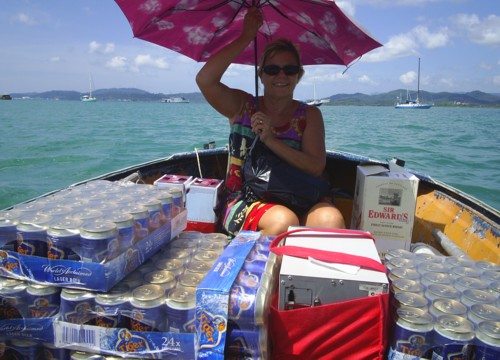
You need an umbrella when you're doing all this hot work!
Travel in and around Thailand is convenient, cheap and enjoyable. And we reckon the very best way to travel around Thailand is by car. So we did a lot of it.
We found, by searching around, we could hire a modern, airconditioned, comfortable car for B500/day (about $AU17). The roads are excellent, well signposted in English and numbered and with not too many cars. And you soon get used to the unwritten road rules that supplement the official ones.
These are:
On highways, it’s OK to drive on the wrong side of the road, even with oncoming traffic and double yellow lines because the shoulder is wide. Whoever is smallest drives on the shoulder. So trucks give way to buses, cars give way to trucks, motorbikes give way to cars and pedestrians give way to motorbikes. Motorbike shops don’t give way to anybody.
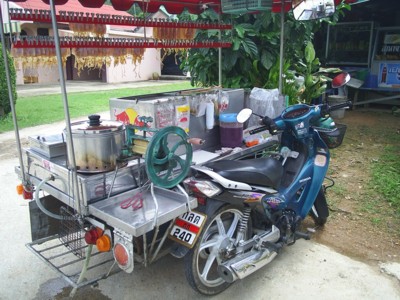
Motorbike shop, Thailand. Motorbike Egg Vendor, Penang
At first, we would never overtake in the face of oncoming traffic but we soon learnt.
Once you get used to it, it’s very logical. You overtake when you need to overtake and the driver on the other side moves over for you. No road rage or horn blaring or frothing at the mouth as there would be in Oz.
Around Phuket it’s (unofficially) OK to go through red traffic lights when there is no traffic. Why sit stopped out of peak hour when there is no other traffic on the road?
Western expats regularly whine in the letters section of the newspapers about how badly Thais drive but we reckon they’re smart.
So we travelled thousands of kilometres by car in Thailand. Lots of short trips of 1-3 days to Ranong on the Burmese border or Satun near Malaysia to do our visa runs every 29 days, but we also drove nearly 4,000 kms over three weeks in May: Bangkok – Chiang Mai – Phrae – along the Mekong River with a flit across to Laos – through Northeast Thailand – down to Pattaya on the eastern side of the Gulf and back to Bangkok.
NE Thailand, or Issan as it is known here, is rural and the poorest part of the country. It is also full of greenest green rice paddies, people net fishing in every lake and stream and farm labourers wearing the pointy style sun hats westerners associate with China or Vietnam.
Northeast Thailand (Issan) net fishing
In your own car you can take the tiny side lanes and discover things you’d never see in a bus: a man making fish traps and people weaving under their houses. Philip loved the home made farm vehicles we saw all through NE Thailand. Usually some sort of wooden chassis with wheels, powered by a single cylinder diesel. Pictures speak louder than words:
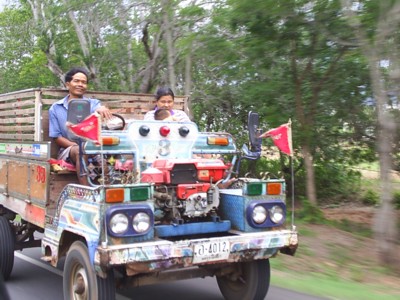
A Couple of Home made Trucks in Northern Thailand
We also came to appreciate the sometimes stupendous loads the Thais were able to fit on their trucks. The trucks themselves were often classic gems.
Thai truck load; Classic trucks on the Mekong River Ferry between Thailand and Laos (Northern Thailand)
Actually, load carrying is one of the lesser known Thai artforms. Look at this typical songthieuw school bus and this 8 year old quadrupling her friends to school on her motorbike and you’ll see what I mean.
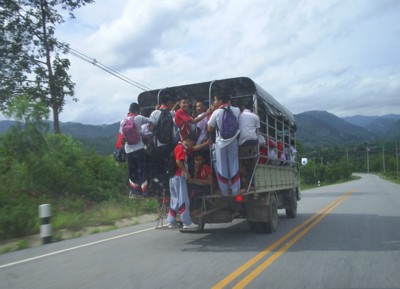
Northern Thailand Songthieuw Schoolbus Four 8 year olds on their way to school on their motorbike
During the cool season we also took a few Thai lessons, from which we learnt quite a bit of new vocabulary, but didn’t master the five different tones. We found that most Thais we were dealing with spoke some English and it was easier for us to understand them than for them to understand us.
Actually we have been surprised at how poor the general level of English is in Phuket, given that it is a tourist place and there are so many farangs here and that everyone learns it at school. But everybody gets by and, what the hell, it’s their country that all us farangs want to be in so they get to choose the language.

I spent a couple of weeks teaching English to a couple of the women at our favourite restaurant and realised that they know a lot of English, but are too shy to speak it.
The rest of the time I did various types of writing and computering and Philip did all sorts of jobs around the boat.
And we travelled! Thailand is so central in South East Asia, it’s easy to get to lots of other countries.
Everyday life on a boat in Ao Chalong
In six months we had time to become Ao Chalong locals – sort of. Just about every day I would do my “work” - our email/internet/online chores at either Khun Gyu’s internet cafe (Air conditioned, good toilets, capuccinos) or “the Kodak” (air conditioned, up-to-date virus/spyware protection, OH&S chairs) or, if I needed wireless connection to update our laptop, I would bring it in to Aaron’s bar, “Happy Days”. This proved very handy for launching the website this year as I had to do it repeatedly until I got the hang of it.
Each evening Philip and I would go for drinks and dinner at one of the small restaurant bars around the waterfront. Our favourite was Khun Ta’s, “The Sailor’s Rest” right on the waterfront at Ao Chalong.
Boy, can she cook! Dry fish curry with shredded kaffir lime leaves and soft shell crab capped off with a couple of Singhas over ice. Mmm mmm.
(And then there was the Issan sausage restaurant, the “little lady who makes the papaya salad whose husband sells insurance” restaurant, the Anchor Inn, where you sit in a kind of treehouse, the Bakery – for an air conditioning fix and their food’s not too bad either – and that’s not to mention the market that forms every night in the main street, Chao Fa Road.) There are literally hundreds of eating places around Ao Chalong.
When we got back to the boat we would watch a DVD (of which we now have an extensive collection) sitting in the balmy night air on the aft deck.
One of the lovely parts of Thai culture that survives even in Phuket, is putting offerings of incense, fruit and flowers on tiny spirit temples (on a stand and about 3 times the size of a letterbox) that are seemingly on the premises of every business or home. Apparently as soon as soil is broken to put up a building, the temple is put in place on the grounds. We were told, when we visited the National Museum in Bangkok, that this is a legacy of Taoist culture and the offerings are to local spirits, but some Thais say they are making offerings to Buddha for good luck.
Whether for religious or other reasons, flower stalls are everywhere. They always sell bunches of orchids and garlands of richly perfumed, white flowers on thread, and sometimes lotus flowers, chrysanthemums and yellow marigolds. Vendors on foot stand at the major traffic lights and sell the garlands to hang on your rear vision mirror. We don’t know if it has religious significance or just makes the car smell nice but we always buy one or two whenever we have a car and often just to hang around the boat.
In fact buying orchids for the table each week is a treat I loved about spending the SW season in Ao Chalong – it’s hard to keep a vase upright on a boat when you’re travelling.
Another luxury is having the laundry done. No laundromats but lots of washing businesses. I love taking our smelly bag of washing ashore in the morning, walking past it washed and hanging on the line in the lane around lunchtime and getting it back folded, perfumed and encased in cellophane in the afternoon. I’m sure Khun Wan sometimes has a sneaky iron as well because our shorts have suspiciously crisp creases along their legs.
Khun Wan and her husband, Khun Ter, have a house on the walkway along the beach where we land the dinghy. As well as doing washing, they have a fishing boat and farm crabs, deliver water and rent out two flats which are at the front of their house.
Doing the Shopping – Thai Style
When we first got to Phuket a year ago I was anxious to buy western goods for Christmas. We discovered “Tops” and “Tesco-Lotus” supermarkets, full of western products – sort of. There were some significant omissions: custard or custard powder (for the pudding) was nowhere to be found, but, more surprisingly, neither was sugar or dessicated coconut. I soon found that the sugar shortage was temporary. Dessicated coconut, on the other hand is unheard of in Phuket. Grated coconut can be bought fresh at the markets (but doesn’t keep so has to be used immediately.)
Since then we found “Big C”, also an air conditioned mall style supermarket, but where the Thais shop. And “Supercheap”.
Supercheap is a huge and fantastic melange of things to buy. Housed in an enormous tin shed with bamboo “stuctural girders”, it is part wet market, part fruit market, part hardware store, part school fete, part supermarket. I’m sure you can buy anything there from motorcycle seat covers to every conceivable type of plastic bag, to toilet bowls to generators to shampoo.
In one section a man grates fresh coconut and makes milk, baskets hanging around his ears. Another section is entirely devoted to different types of fish sauce! And there’s a shoe section opposite the lady deep frying pastries. You have a proper supermarket trolley and in many parts the goods are on ordinary supermarket shelves and there are checkouts. Outside of the store – but still in the tin shed – is the “food hall” with all the usual Thai snacks.
The Thais come here to stock their shops and you see their trolleys exiting for the car park stacked high with bulk purchases. It’s a real experience.
The trip to Malaysia made us even more aware of the availability of wonderful fruit in Thailand. Pawpaws are everywhere all the time. Delectable orange flesh that is quite different from Australian pawpaws. I gorged on lychees and a particularly sweet type of mango all through May. And wait ‘til you taste jackfruit fritters in coconut batter. Even the bananas are sweeter in Thailand. Etc etc etc
A funny thing at the markets and shops here. Fruit and vegetables are almost never sold together. It is either a fruit stall or a vegetable stall. The longer we have been here the more we buy from the markets rather than supermarkets. Even meat or seafood. Yes, it’s unrefrigerated but there don’t seem to be too many food related deaths among the locals (they’re mostly being mown down on their motorbikes). Not that we buy a lot of fresh stuff as we eat out most nights.
Thai Helpfulness
It ’s a cliché (but true) to remark on how friendly and helpful the Thai people are. We had a good example of that Thai “something extra” the other night.
We’d gone ashore at Koh Lanta to have our first Thai meal since we’d been back in Thailand at one of the pretty little thatched restaurants that line the sand.
A couple of hours later, before we went for a late night stroll along the beach, Philip checked the tinnie, which we’d left anchored on chain and a long rope with an incoming half tide. It was full of water, side on to the small waves which were breaking continuously into it and sucked into the soft sand. Immovable.
Fortunately we had a bailer and our friend, Rod’s “patented” bilge pump of 2” water pipe and we set to work. But the more we bailed the more the waves broke into the boat. We weren’t getting anywhere.
Suddenly a young Thai stranger jumped into the boat grabbed our bailer and started bailing two handed at a hundred miles an hour. Within minutes the water was at a manageable level and the boat had some flotation again. Off he went and we continued bailing and dragging the dinghy up the beach so we could drain the 2” of sand that had packed itself into the bottom.
To drain the sand we had to remove the bung and start bailing water INTO the dinghy, while agitating the sand with our fingers. Again, out of nowhere, a not so young Thai woman got right into it, up to her elbows in sand and salt water, oblivious of her clothes and her hands. (I took the skin off my fingers.)
This whole process took several hours and we provided a bit of interest for the farang tourists strolling the beach in the balmy night. Philip rowed us the 500m out to Lifeline when the engine wouldn’t start. Fortunately, next day, the outboard was OK, once we realised the problem - we hadn’t inserted the engine cutoff key (otherwise known as “the red thing”).
We ran our fuel through the baja filter a couple of times to remove any water (the tank had floated and upended itself) and Philip WD40’d anything in sight. Hopefully the depth sounder will still work after its plug was given a bit of a dunk.
Penang
Philip has just read this and says I didn't tell you about Penang. But I definitely rabbited on about it in the 2005 Malaysia Cruise log so I'll just include these couple of photos:


